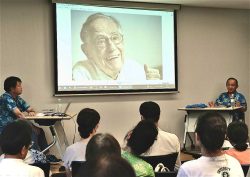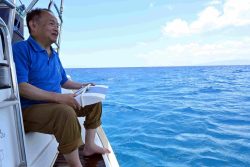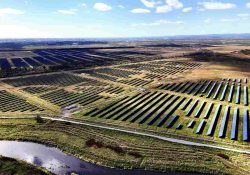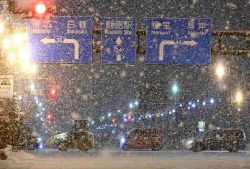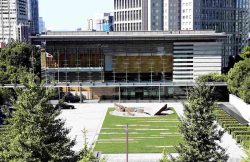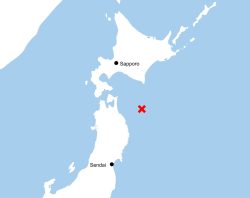
Donald Keene at his mountain cottage in Karuizawa on Sept. 7, 2017. That summer was the last time he stayed in Karuizawa.
6:00 JST, August 24, 2022
A special exhibition dedicated to Japanologist Donald Keene’s time in Karuizwa is underway at the Literary Museum of Karuizawa in Nagano Prefecture.
Keene, who passed away in 2019 at the age of 96, promoted Japanese literature and culture to the world throughout his life. He had a small cottage in Karuizawa, a traditional Japanese-style house of only 10 tsubo (about 33 square meters), a hermitage nestled in deep greenery and silence at the foot of the mountain.
He spent every summer here for more than half a century, devoting himself to such work as his translation of “Essays in Idleness” (Tsurezuregusa) into English, and enjoying friendships with prominent writers. I visited the special exhibition — titled “Donald Keene 100th Anniversary Exhibition: Karuizawa and the Beauty of the Japanese Language” — to learn more about the connections between Keene and Karuizawa.
“I wanted a house with old Japanese culture, so first I looked in Kyoto, Nara and Kamakura. In the end, however, I settled on Karuizawa,” Keene was quoted as saying in a local newspaper on Aug. 16, 1966. He had acquired the cottage the year before.
“Japanese writers and university professors that I work with, including Yasunari Kawabata, all gather in Karuizawa,” said Keene, who was then 43 and a professor at Columbia University in the United States.
“In Tokyo, they are very busy people, but in Karuizawa, I can enjoy their company and it’s very convenient. On top of that, it’s quiet and great for studying. Karuizawa is an ideal summer resort.”
According to Toshiyuki Ohto, the deputy director of the Literary Museum of Karuizawa who guided me through the display, Keene’s relationship with Karuizawa dates back to the 1950s. Keene had been invited there several times by Michio Nagai, a lifelong friend whom he met while studying at Kyoto University and who later served as education minister. Keene stayed at Nagai’s mountain cottage in Karuizawa.
In 1964, Keene bought a piece of land for the first time in his life near Nagai’s mountain cottage. He gave a local carpenter a rough design and asked him to build a Japanese-style house, after which he left for Columbia University.
When he returned to Karuizawa in June of the following year, he was very satisfied with the finished structure. The carpenter had taken his time and worked carefully without using a single nail, and the building exceeded Keene’s expectations. What’s more, it was cheaper than the estimate.
From then on, Keene spent his summers in Karuizawa for more than half a century, his final visit ending on Sept. 10, 2017. He also visited the Literary Museum of Karuizawa several times, including the Shusaku Endo exhibition held in 2013.

Left : The Literary Museum of Karuizawa, surrounded by greenery
Right : Keene’s handwritten manuscript describing the charms of Karuizawa
Work in Karuizawa
Keene was fascinated by the literature of Basho Matsuo, and it was at his hideaway, located in a dense forest of pine trees and oak trees, that he produced many of his works.

Keene’s English translation of “Essays in Idleness,” his first work in Karuizawa
The first was an English translation of “Essays in Idleness,” typed on Keene’s favorite typewriter. In the magazine “Tosho” (No. 833), Keene wrote: “It was the rainy season. Rain seems to have a strange magical power to give me concentration and persistence. As I translated, I felt as if I were writing ‘Essays in Idleness’ myself. I might actually have been [the author] Kenko at that moment.”
With only a simple kitchen in the front and a study desk and bookshelves in the back, the cottage seems to have become a place where Keene could immerse himself in the world of his work.
Nagai’s daughter, Ikuyo, recalled that when Nagai visited one day and remarked on how quiet it was, Keene replied with a smile: “It’s quiet. Other than you, Nagai-san, only little birds visit here.”
Keene continued to use the house as a base for many of his works, including the English translation of Yukio Mishima’s “Madame de Sade,” classic literature such as “Chushingura” and the writing of his last book, “The Life of Ishikawa Takuboku.”
He also enjoyed taking walks and deepening his friendship with the literary giants who spent their summers in Karuizawa, as well as with visitors and local people.
Summer with Seiki Keene
Seiki Keene, who was adopted by Keene in 2012 when he became a Japanese citizen, shared with me his memories of Karuizawa.
Keene called Seiki “Asazo,” his stage name from his days as a bunraku shamisen player. One day in Karuizawa, on the way home from a shopping trip in a car driven by Seiki, Mt. Asama was clearly visible.
Keene said, “Asazo’s here, so let’s call Asama-yama (mountain) Asazo-yama. Asazo-yama looks splendid today. Asazo-yama, hooray!” Keene shouted in the car many times. He was always listening to opera CDs in the car.
In 2016, the hideway was expanded and remodeled to have 13 tsbuo with a new dining and reception room. Father and son lived comfortably in Karuizawa.
The year before his death, 2018, was to be the last time they would be in Karuizawa. Keene repeatedly said, “Let’s go to our Karuizawa.” However, after consulting with his doctor, his wish was never granted.
“The six summers I spent with my father in Karuizawa shine like jewels in my heart,” Seiki wrote in the Literary Museum of Karuizawa’s booklet “Kogen Bunko” about the 100th anniversary exhibition. Seiki is representative trustee of the Donald Keene Memorial Foundation.

The Donald Keene special exhibition
The Literary Musemu of Karuizawa
The special exhibition on Donald Keene features five themes from Keene’s life, exhibiting his first work in Karuizawa, the English translation of “Essays in Idleness.” Also on display are wealth of other works and materials, as well as paintings and ceramics from his collection.
Keene’s study in Karuizawa has also been recreated, including the typewriter and desk stand he used when translating “Essays in Idleness” into English.

Left : The study in Karuizawa’s cottage. The desk, pencil sharpener and other items were all used by Keene.
Right : Exhibition introducing Keene’s relationship with Karuizawa
***
The special exhibition will run through Oct. 10. The museum is open every day from 9:00 a.m. to 5:00 p.m. For more information, please visit the Literary Museum of Karuizawa website (http://kogenbunko.jp/)
"JN Specialities" POPULAR ARTICLE
-

English-language Kabuki, Kyogen Entertain Audiences in Tokyo; Portland State University Professor Emeritus, Graduates Perform
-

Noodle Dining Shunsai / Rich Oyster Ramen to Savor at Odasaga; Experienced 68-year-old Owner Creates Numerous Ramen Varieties
-

The Japan News / Weekly Edition (12/5-12/11)
-

Yomiuri International Cooperation Prize: Prize fosters future generations of professionals
-

The Japan News / Weekly Edition (12/12-12/18)
JN ACCESS RANKING
-

Japan’s Hopes for Seafood Exports Shot Down in China Spat
-

Essential Services Shortage to Hit Japan’s GDP By Up to ¥76 Tril. By 2040
-

Japan to Charge Foreigners More for Residence Permits, Looking to Align with Western Countries
-

Japan Exports Rise in October as Slump in U.S. Sales Eases
-

Niigata Gov. to OK Restart of N-Plant; Kashiwazaki-Kariwa May Be Tepco’s 1st Restarted Plant Since 2011



